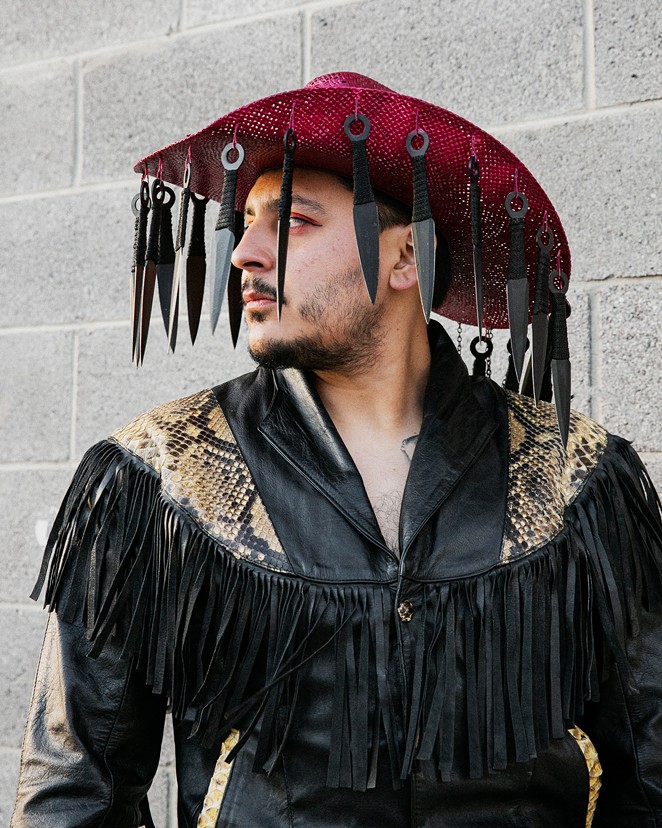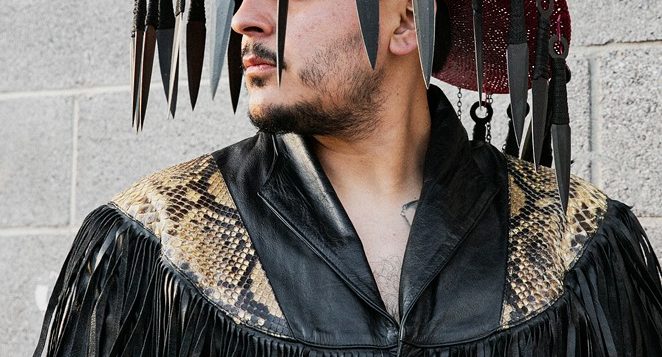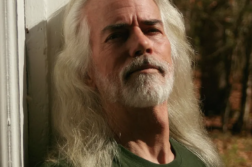I FIRST SAW José Villalobos’ work in Houston at a performance art festival, Experimental Action. His performance, in which he stained a solid white, western-style suit with the vibrant magenta juice of prickly pear cactus fruit, was spellbinding. I continue to be fascinated by his exploration of Southwestern culture, queerness, and masculinity. His work has been shown extensively throughout Texas, but he has also had installations and performances in Chicago, Pittsburgh, New York, and Atlanta, among other places.

Villalobos grew up in the Texas border city of El Paso. He made regular trips with his family across the border into Ciudad Juarez, where they had extended family. It was a very traditional and religiously conservative family, with strict expectations of gender roles. His father died when he was ten, and from then on the instructions in masculinity came from his uncles and brothers-in-law. He was also a gay little boy, trying to navigate the border between the expectation of machismo and his queer desires. When he came of age, he left El Paso and attended college at the University of Texas at San Antonio, where he fell in love with contemporary art and performance.
This interview was conducted in April via Zoom.
Neil Ellis Orts: Tell us a bit about your childhood.
José Villalobos: I was always creative as a kid. My brother would get so mad when we would play Legos, and I’d come up with the cool stuff, and he was like “How the hell did you do that?” I would try to make dresses for the Barbies my sisters had. That was something that I wouldn’t let my parents see me do.
NEO: No one ever told you “Boys don’t make dresses”; you just instinctively knew that would not be welcomed?
JV: Right. And I remember seeing fashion designers portrayed on TV, and when it was a male, he was always a very flamboyant character, and I didn’t like to be compared to that. Any mannerisms that were considered feminine—there was always correction. “Don’t be running like a little girl! Don’t put your hand like a faggot!” Or being called “Juanga” (Mexican singer Juan Gabriel). He was an icon, an idol, and we all know he was queer, but when that question came to him, he would say: “What you see you don’t ask about.” To be compared to him, I’d get so angry and I’d get sad at the same time.
NEO: I find it interesting that you were making Barbie clothes because so much of your work now involves transforming clothes. Talk about the altered cowboy hats you make.
JV: I wanted to use something culturally relevant, something I grew up seeing. The dynamic around a cowboy hat is very particular. It almost acts as a crown. It is a symbol of power. It is a signifier of the man and his machismo. I was interested in how I could deconstruct the masculinity behind that object. The hat became a different symbol. It was used to present myself, but also to hide myself, trying to understand the power, but also hiding from it.
A lot of inspiration came from looking at drag queen apparel: sequins and appliqués and fringe. It’s a combination of a lot of things, but my question was, how can I make something that holds this power of masculinity and machismo, and how can I soften the virility behind it? How can I make it flamboyant? How can I queer it up? The creations all are different. Some of the hats will allow you to see my face a little more. There is also one that I’ve done that is on the more aggressive side, with knives on it.
Also, there’s this weird dynamic that exists among men, especially norteño men. It’s okay for these cis straight men to have these heavily decorated suits or belts or boots because they’re straight, but as soon as you have someone who’s queer doing that, now you’re a faggot, now you’re someone who is too much. Even when we talk about the designs of boots, those boots are highly ornate and heavily decorated, from the stitch patterns to the type of exotic skins that are used.
NEO: Which brings me to Botas Para Llegar Al Cielo. I’ll never look at cowboy boots the same way. When did you look at boots and see wings in the stitching?
JV: My mom’s boyfriend is a boot maker, and I have some of his original patterns that he created. I was simply playing around with materials and cutting out the pattern. I started doing some digging into my past and the idea of religion and how we’re constantly told we’re not going to make it to heaven. I had the opportunity to create this installation through Gil Rocha [curator of The Border Is a Weapon at the Pittsburgh Cultural Trust]. I created these boots [with wings]ascending. It was based on being a kid and hearing that you can’t go to heaven if you’re queer. But if we’re told we’re not going to make it their way, we’re going to have to make it our own way.
NEO: What are you exploring now?
JV: I’m interested in looking at history or historical moments in which we never hear about queerness. I think it’s important to talk about that and bring it into the light. We have been oppressed for a very long time, and, as a brown person, there is a further oppression that exists. When we look at these historical moments, we don’t even bother to question if there were any queer individuals.
I had this installation at Artpace [San Antonio] called De Los Otros, which is specifically talking about the Mexican migrant farm workers, the braceros, who were contracted by the government to take care of the farmlands during World War II. My grandfather was a bracero, and he was a part of that program. One of the centers at which these men were processed as they crossed over [into the U.S.]was in El Paso. I visited the site and did the research, and then came the question: was there anyone who was gay? You’re in a barracks full of men, or in the fields and it’s just men, but you never hear about a queer individual. I was reading a book by Mireya Loza [Defiant Braceros: How Migrant Workers Fought for Racial, Sexual, and Political Freedom, 2016] that talks about the culture that existed with the braceros, and there’s an interview in which she’s asking if there was anyone who was queer. They start talking about a specific individual, and his name was Porfirio. That is a lost story. I’m going to continue that work.
Neil Ellis Orts is the author of the novella Cary and John (2020).






